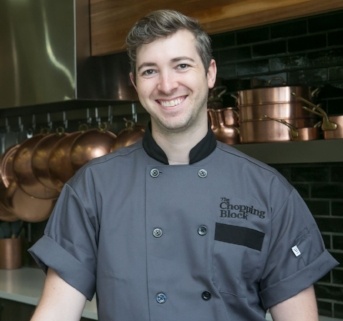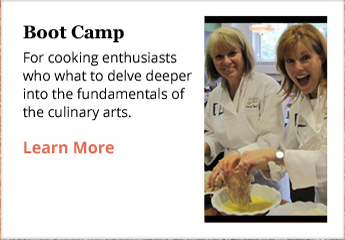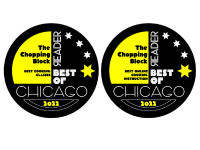What goes on in the kitchen of a restaurant can be a bit of a mystery. Even if the restaurant has an open kitchen, by the time the public at large is looking on, almost all the work has already been done. As a rule, restaurants want to leave as little work for the cooks on the line during service as possible. Anything that can be prepped ahead is, so when it comes time to actually serve guests the pickups are quick and efficient. This makes service run more smoothly and quickly, which allows the restaurant to feed more guests, which allows the restaurant to make more money (which is, I suppose, the whole point).
 Due to the necessarily opaque nature of most restaurant kitchen work, I feel like not many people in the general public have a sense of how it works, and in what ways it differs from preparing a meal at home. For this reason, I thought it might be interesting to walk you through what it looks like for me to complete one prep task for the restaurant at which I work. I’m going to focus on just one project because trying to show the whole prep day would be a bit too much, and because documenting it all would have seriously undermined what is one of the main concerns of restaurant prep work: speed.
Due to the necessarily opaque nature of most restaurant kitchen work, I feel like not many people in the general public have a sense of how it works, and in what ways it differs from preparing a meal at home. For this reason, I thought it might be interesting to walk you through what it looks like for me to complete one prep task for the restaurant at which I work. I’m going to focus on just one project because trying to show the whole prep day would be a bit too much, and because documenting it all would have seriously undermined what is one of the main concerns of restaurant prep work: speed.
So for a bit of context, I work at a busy but fairly small (40ish seats) French bistro-style restaurant. I’m going to show how I prep the ricotta gnocchi set, and the amount I make will last the restaurant between two to four days. Very little of what a restaurant (even a very high end one) serves on a daily basis is made every single day.
For the rest of the post ,I’m going to let the photos and videos do most of the talking, with just some descriptions to let you know what is happening and why.
 As with most things in the kitchen, it starts with mise en place. I gather everything I’ll need to complete the task before starting. This streamlines the process significantly. Here we see ricotta impastata, Italian 00 flour, and eggs which we buy from the small farm of one of our bartenders.
As with most things in the kitchen, it starts with mise en place. I gather everything I’ll need to complete the task before starting. This streamlines the process significantly. Here we see ricotta impastata, Italian 00 flour, and eggs which we buy from the small farm of one of our bartenders.





 The wet ingredients are weighed out, seasoned, and mixed, then the same happens with the dry. Once a dough is just formed, I move to the wooden surface for rolling.
The wet ingredients are weighed out, seasoned, and mixed, then the same happens with the dry. Once a dough is just formed, I move to the wooden surface for rolling.







 Here we see the dough come together, and rolled into a long thick log before being divided into 12 smaller portions for further rolling. This is about four pounds of dough, by the way, and will make roughly 20 portions of gnocchi.
Here we see the dough come together, and rolled into a long thick log before being divided into 12 smaller portions for further rolling. This is about four pounds of dough, by the way, and will make roughly 20 portions of gnocchi.



 The short segments get rolled into long ropes. Consistency is key here. We want all the gnocchi to be basically the same size, so it's important to be able to roll each rope without any bulges or thin spots. Once they're all rolled I lay them out in groups of four for cutting.
The short segments get rolled into long ropes. Consistency is key here. We want all the gnocchi to be basically the same size, so it's important to be able to roll each rope without any bulges or thin spots. Once they're all rolled I lay them out in groups of four for cutting.



I use a bench scraper to cut the gnocchi into roughly one inch pieces. This causes the ends of the gnocchi to get pinched slightly so they need to be rolled again to regain their cylindrical shape. Its taken me a while to get this technique down but now I can do this final roll to many gnocchi at once as shown in the video (I do it with two hands when one isn't occupied holding the camera). Once the gnocchi are finished they all get loaded on a sheet tray and stashed in the walk-in cooler until the water for poaching them is at a boil.




 The gnocchi are loaded into a large (about 18” in diameter, and 6” deep) rondeau pot all at once. Once they float to the surface, I allow them to poach for just a minute or so longer to make sure they’re cooked through. Then they get chilled directly in an ice bath to stop the cooking where I want it. Now it’s time to put together the rest of the set and portion everything out.
The gnocchi are loaded into a large (about 18” in diameter, and 6” deep) rondeau pot all at once. Once they float to the surface, I allow them to poach for just a minute or so longer to make sure they’re cooked through. Then they get chilled directly in an ice bath to stop the cooking where I want it. Now it’s time to put together the rest of the set and portion everything out.





Here we have all the bits that go in the pan with the gnocchi on pickup during service. Clockwise from the top left, we have chanterelle mushrooms sautéed with herbs and garlic, sliced green garlic, blanched asparagus, and triple blanched julienned lemon zest. I lay out an array of pint size deli containers and load each one up with 20 gnocchi pieces. Then a cup container goes on top of each pint and is filled with the proper portions of the rest of the components of the set. This setup allows everything to be added to the pan quickly and accurately during service. From here, every container gets a lid and is stored in the walk-in until it's needed.
And there you have it! One prep task complete. I hope this was an interesting look into restaurant life that helped you gain some perspective about the differences between professional and home cooking. Maybe it even inspired you to get some professional level instruction to up your own kitchen game at home. If so, I recommend checking out our upcoming Essential Building Blocks or Culinary Boot Camp classes. Happy cooking!
Learn More about Culinary Boot Camp











